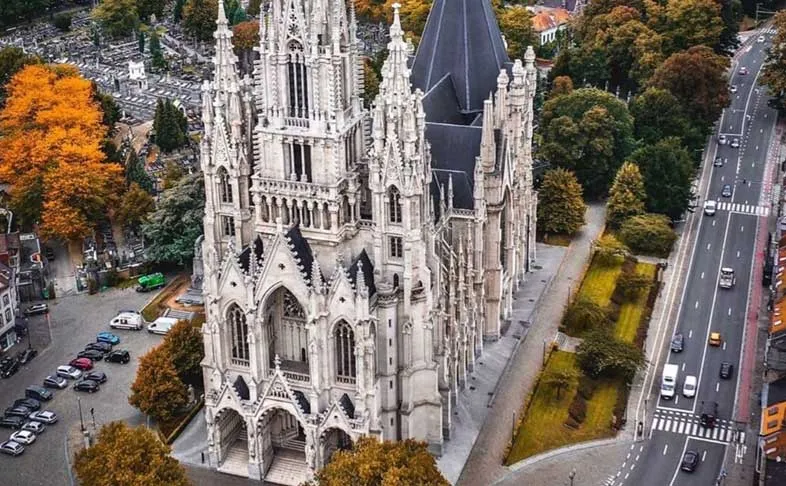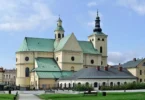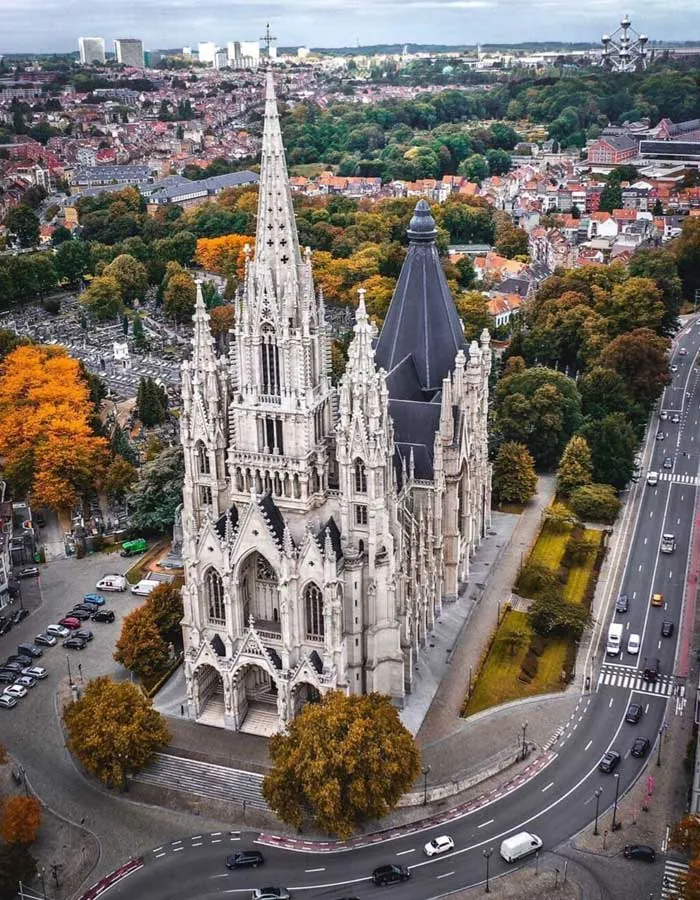
Introduction
The Church of Our Lady of Laeken (French: Église Notre-Dame de Laeken, Dutch: Onze-Lieve-Vrouwekerk van Laken) is a neo-Gothic Roman Catholic church in the Brussels district of Laeken, Brussels, Belgium. It was originally built in memory of Queen Louise-Marie, wife of King Leopold I, to the design of the architect Joseph Poelaert.
Louise-Marie died in Ostend in 1850 and wished to be buried in Laeken. The nearby Royal Castle of Laeken was, and still is, the royal residence. Leopold I wished the church to be constructed in her memory and as a mausoleum for her. The young architect Joseph Poelaert was chosen to design the new church.
The first stone was laid by Leopold I in 1854. The church was consecrated in 1872, but not completed until 1909 after a lengthy interruption of the work. The crypt holds the tombs of the Belgian royal family, including those of all the former Belgian kings.
The Royal Crypt underneath the shrine is the main resting place for the members of the Belgian Royal Family, with some notable artisans also interred at the nearby cemetery. The venerated Marian image enshrined within was crowned in 1936 by pontifical decree.
History of Church of Our Lady of Laeken, Brussels
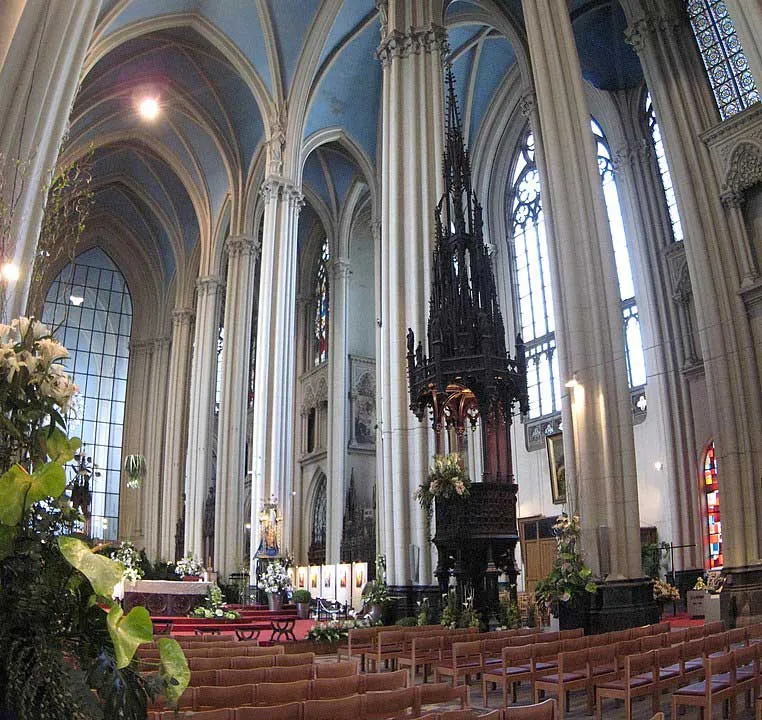
One can only conjecture the origin of the old Church of Our Lady of Laeken which was perhaps already an estate in Carolingian times. Thus, according to a scholar of the 15th century, it was consecrated by Pope Leo III (pope from 795 to 816) who passed there in the company of the Emperor Charlemagne.
Another scholar, Quentin Hennin, parish priest of Laeken in the 16th century, affirms that it would have been founded by two virgins who built it in memory of their brother, Duke of Germania, who died fighting the infidels “in full view of Brussels’. If contemporary authors find the first of these stories more likely, it remains nonetheless unverifiable.
It is certain that in the 13th century there was a Gothic church in the center of the village of Laeken. A curious legend is linked to its construction. Every morning, the workers who had begun to build the foundations found their work of the day before destroyed. On the fourth day, they hid to surprise those responsible. They found themselves facing the Virgin Mary, Saint Barbara and Saint Catherine.
The Virgin left behind a thread indicating the orientation and dimensions to be given to the oratory. In 1633, this thread, which was the object of veneration and to which miraculous powers were attributed, was stolen. The culprit of this desecration was quartered and burned on the Grand-Place in Brussels. In addition to this thread, a statue of Our Lady was venerated in this sanctuary to which tradition and many legends also attributed miraculous power.
In the 17th century, the active sponsorship of the Archduchess Isabelle added to the notoriety of the place and made the church a place of assiduous pilgrimages. It organized great pedestrian processions which left from the cathedral of Brussels and which ended in the church of Laeken. She then rested at Coensborgh Castle, Drève Sainte-Anne, before returning by “car”. Period illustrations show the church surmounted by a square central tower, extended on one side by a chapel dedicated to Saint Barbara and already surrounded by a small cemetery.
From 1781, the last governors of the Austrian Netherlands , Marie-Christine of Austria and Albert of Saxe-Teschen built near the church of Laeken the castle of Schoonenberg (or Beaumont) which served as their residence. of summer. The castle later became the property of Napoleon I, then of Guillaume d’Orange who enlarged it. Leopold I, the first king of the Belgians, chose it as his private residence. Under the name of Château de Laeken, it is still today the residence of the Belgian sovereigns.
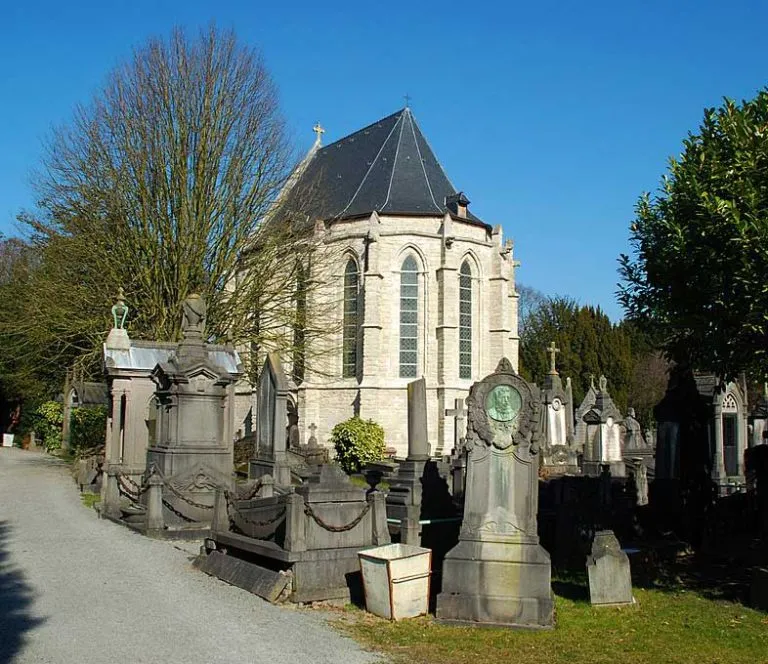
New Church
Although she died in Ostend (1850), Louise-Marie d’Orléans wanted to be buried in Laeken. His body rested for a few years in the old church of Laeken. To honor the memory of his wife, Léopold Ier conceived the project of a new and large church of Laeken. By royal decree of October 14, 1850, the government authorized the construction of the building and organized a competition, the rules of which stipulated that the church should be able to contain 2,000 people and that its price should not exceed 800,000 francs.
In 1852, the jury retained one of the projects presented by a certain Paul Du Bois, pseudonym of Joseph Poelaert, then a young architect 34 years old. The project initially selected was a fairly simple brick building with stone bands and whose facade was surmounted by a single spire covered with slate. In 1853, the jury proposed to modify the project in the direction of greater monumentality, with a neo-Gothic facade with three arrows.
This led to an overrun of the initial budget, which was the first of a long series. In 1854, Leopold I himself laid the first stone of the new building. In 1865, Poelaert, absorbed by the Brussels courthouse project since 1862, claimed health problems and gave up the management of the works. Several architects succeeded him: Auguste Payen, Antoine Trappeniers, Louis de Curte and Alphonse Groothaert.
The building is monumental and although consecrated in 1872, apart from maintenance and consolidation works, its completion was resumed only after a long interruption. It was Leopold II, concerned about the embellishment of the place, who, in 1896, relaunched the project still compromised by the lack of funds.
In 1902, as the building continued to deteriorate, a Munich architect, Baron Heinrich von Schmidt, was commissioned to carry out a general examination of its condition. In 1907 the government approved his plan to complete the main facade, the monumental porches and the central tower. This work was carried out from 1909 to 1911.
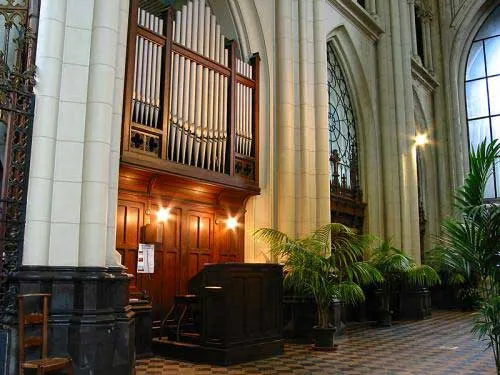
Architecture
The incompleteness of the carvings of the tower and the facades results in the existence in protrusions of large blocks arranged in a repetitive way which were intended to be carved on the spot according to the traditional use, which was never done. As early as 1886, a report by the Minister of Agriculture to the Royal Monuments Commission made the distressing observation.
“If the monument were to be completed in the rich and elaborate style of Poelaert, several million more would be needed. It was therefore necessary to interrupt the work, not only to limit the expenses by avoiding for example an excess of ornamentation, but also, because the stone being very soft, it was necessary to be very sober in the details.
During the restoration begun in 2003, made necessary by the degradation of the stone due to pollution, the architecture, specialist in interventions in traditional buildings, could only advise not to touch this particular aspect of the building, the aging of the stone prohibiting any sculpture at the risk of causing damage with irreversible consequences.
We limited ourselves to treating the exterior parts of the church against acid rain and, therefore, these cubic forms in a Gothic architecture where everything is sculpted in traditional forms, in particular vegetal, appear as a curiosity that habit has devoted to the point that many believe it to be a purposeful modernist interpretation of the Gothic style.
As we wanted, for urban planning reasons, that the main facade of the church should be oriented towards the center of Brussels, the choir is not oriented towards the east, as is generally the case, but towards the north-East.
Royal Crypt
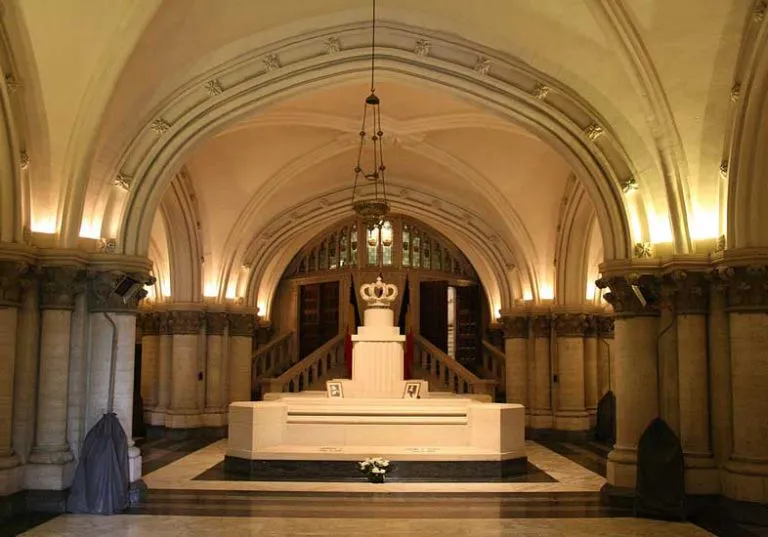
The Royal Crypt of the Belgian Royal Family, also called the Crypt of Laeken, is the place where the monarchs of the Kingdom of Belgium and their wives were buried, as well as certain other members of the royal family.
The Royal Crypt of Laeken is located in our Notre Dame de Laeken church in the basement. It is accessible to the public for visits. Admission is free and without reservation.
Cardinal Joseph Cardijn
Cardinal Léon Joseph Cardijn (November 18, 1882 – July 24, 1967) Son of a Flemish charcoal burner, Léon Joseph Cardijn, who had become a priest, formed a group of young Christian workers in his parish near Brussels. In 1924, in line with the encyclical Rerum Novarum, he created the Jeunesse Ouvrière Catholique (JOC), called to great international influence throughout the 20th century. The cardinal’s tomb is in the Notre Dame de Laeken church.
The Two Organs
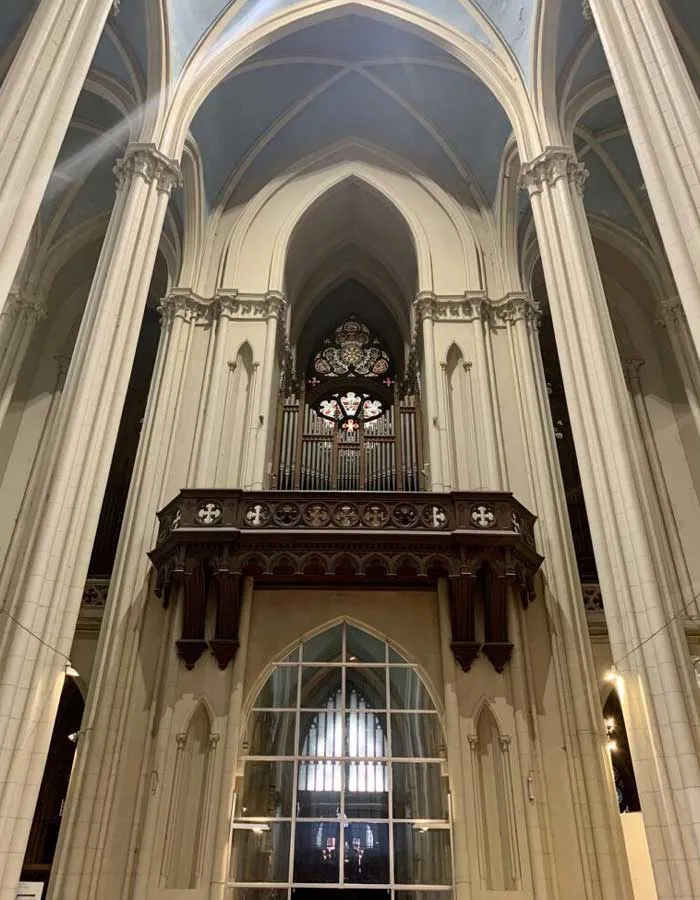
Great Schijven Organ – Van Bever 1874-1912. It is a gallery organ (Schyven-Poelaert-Goyers / Van Bever, 1874-1912). The great organ of the Church of Our Lady of Laeken was built between 1872 and 1874 by Pierre Schyven and inaugurated in the presence of King Leopold II by Alexandre Guilmant and Auguste Mailly.
Dismantled in 1908 by the Laeken organ builder Salomon Van Bever, it was rebuilt in 1911 with the addition of a Positif. This transformation has cost us the loss of the magnificent neo-Gothic case that adorned Schyven’s organ.
On May 10, 1912, a solemn concert given by Louis Debond closed the work. In 1975 the Ministry of Public Works decided to restore the instrument.
This work was entrusted to Patrick Collon, organ builder in Laeken. Thus restored, the Schyven-Van Bever organ of the Church of Our Lady of Laeken constitutes one of the most prestigious witnesses of the building of romantic organs in Belgium.
Neo-Gothic Chancel Organ (Van Bever, 1907). The choir organ was built in 1907 by Van Bever Frères and restored in 1996 by Étienne De Munck, allowing perfect and harmonious play with the great organ.
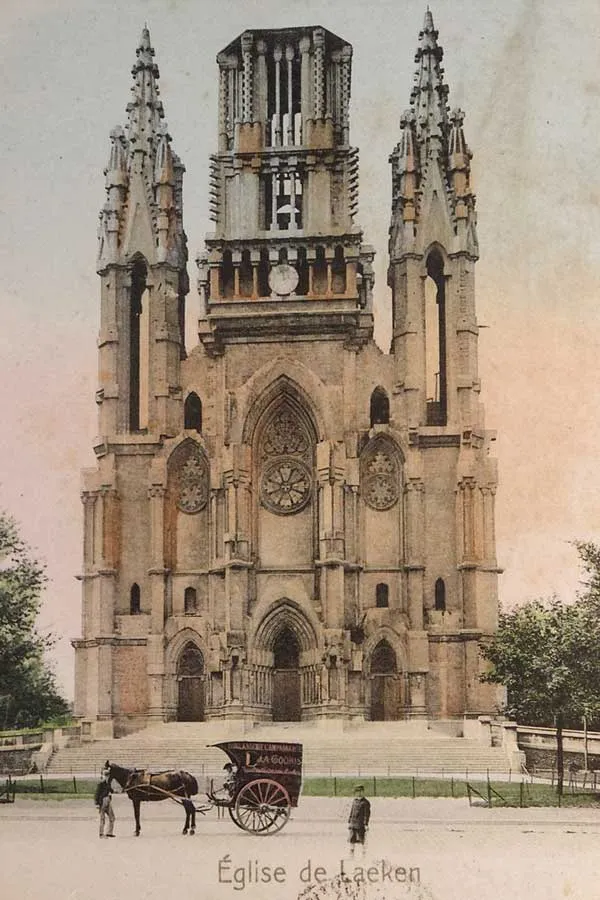
Church Factory
The church factory is a public establishment which manages, under the supervision of the archbishop and the administrative authorities, the goods intended for public worship, in order to ensure the financial means for a worthy exercise of this worship. It has civil personality.
The statute, the task, the competence, the composition and the functioning of the church factories are essentially governed by the imperial decree of December 30, 1809, supplemented by the law of March 4, 1870 and modified by the ordinances of the Region of Brussels – Capital of July 18, 2002 and February 19, 2004.
The factory council has seven members: two members by right and five elected members. The members of right being the canonical priest of the parish and the mayor of the commune. The latter is generally replaced by a municipal councillor. Elected members serve a six-year term.
The church council appoints a president, a treasurer and a secretary who, together with the parish priest, is responsible for the day-to-day management.
Feast Day - 15th August
The Feast Day of the Church of Our Lady of Laeken in Brussels, Belgium is celebrated on August 15th. This date corresponds to the Assumption of the Blessed Virgin Mary, a significant event in the Catholic calendar. On the feast day, the church holds special religious services, processions, and other commemorative events to honor the Virgin Mary and celebrate the religious heritage of the Church of Our Lady of Laeken.
Mass Time
Weekdays
Saturdays
Sundays
Church Visiting Time
Contact Info
Square du Cardinal Cardijn 6,
1020, Brussels (Laeken), Belgium.
Phone No.
Tel : +32 2 478 20 95
Accommodations
How to reach the Church
Brussels Airport is an international airport in Brussels, Belgium is the nearby Airport to the Church.
Princesse Clémentine Tram Stop in Brussels, Belgium is the nearby Train Station to the Church.

